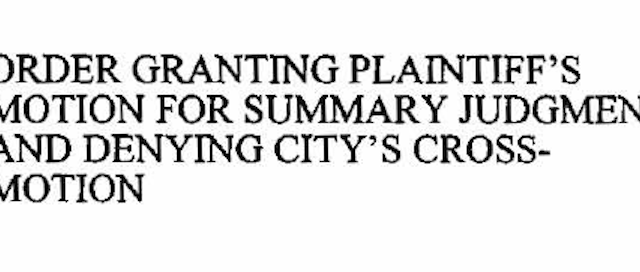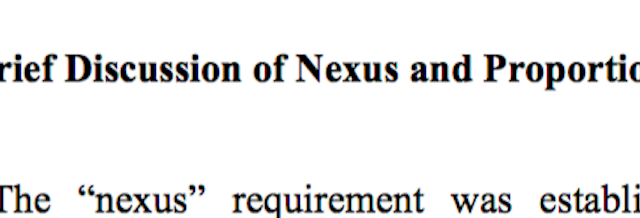Defining “Affordable”
I think the way we talk about affordability isn’t just sloppy it actually makes the problem worse. When we talk about what affordable means we need a better measure. I have an article in the September edition of the Master Builder Magazine that takes this topic up yet again. My original post on this was from my days at Sightline when I suggested a different model for talking about affordability. I also wrote about this in Publicola as well. Here’s snippet of my latest on this topic:
Instead, we should develop a smarter tool to measure a family’s economic distress and create innovative programs that help struggling families afford to live in a growing city like Seattle—programs that increase income and reduce the cost of living.
Abutting Lot Decision: What Would an 82.02.020 Challenge to MIZ Look Like?
I’m not a judge and I don’t even play one on tee vee, but if I was a Judge asked to deliver a summary judgement on the legality of the City’s Mandatory Inclusionary Zoning (MIZ) program, what they call Mandatory Housing Affordability (MHA), what would I find and how would I rule? What kind of arguments would be made by a plaintiff developer and how would the City defend the MHA program? Here’s how I think a case would unfold. It’s important to note that we have no numbers or actual upzones passed that would implement MHA and we can’t know what a legal challenge would look like until someone actually files a case. But let’s take a look at a rough sketch of what the facts might look like, how the law might be argued, and a possible decision.
First, a developer would likely file a suit against the City because she bought land in a zone affected by the MHA upzones. Maybe she was planning to build a 50 unit apartment building in a low-rise zone. The MHA would have given her, maybe, a 10 percent increase in FAR, perhaps one more floor of height. She tried to account for the changes in zoning in her pro forma, but the market has changed. She figured she could offset the construction costs for the extra capacity she is allowed to build by increasing the rents in the building to pay the fee in lieu. When she compared the two options of performance, she, her investors, and partners decided the fee was more economical.
But rents have been dropping since the process to close the deal started. The land and the whole deal depended on her being able to charge more rent to offset the fees she had to pay. Now the bank and the investor think the proposed rents are just too high. She doesn’t have to build the additional height, but she still has to pay the fee since the MHA program requires the fee or inclusion whether she builds the additional square footage or not. Her choices are to buy the land and wait or to lose the money she’s already invested in design and getting ready to submit for permits. She decides to sue the City in Superior Court in an as applied fact based challenge under RCW 82.02.020.
The plaintiff’s argument is that the requirement fails the nexus and proportionality test under RCW 82.02.020 because she is being charged a “tax, fee, or charge, either direct or indirect, on the construction or reconstruction of residential buildings” specifically disallowed under State law. Furthermore, the City’s program is not voluntary and has not established that the fee would “mitigate a direct impact that has been identified as a consequence of a proposed development,” specifically her development. Like the abutting lot case, the plaintiff’s attorney argues that she is being forced to pay for impacts that are not directly related to her project and these fees are not reasonable as case law requires, especially, like the abutting lot requirement, they will require her project to lose money to pay the required fee.
The City counters in its defense that a study established a link between the development of new housing and the need for subsidized housing. In a nexus study commissioned by the City, a consultant said,
To the extent that new market-rate residential and commercial development in the City increases demand for housing and exacerbates the City’s shortage of affordable housing, the City has a strong public interest in, and a legal basis for, causing new affordable housing to be developed to meet this additional demand.
The City would present expert witnesses that would essentially argue that new housing pushes up the overall price of housing creating a demand for subsidies that the City must pay to help poorer people live in the City. Therefore, the plaintiff should pay a proportional share toward mitigating the impact it is creating which forces the City to build or fund the building of subsidized housing. The counter arguments here are likely to be based in two things, economics in general that would or would not establish a nexus, and the specific fee and whether it is proportionate to the need to mitigate the impact. I haven’t the foggiest idea about the specific numbers. That’s going to be very interesting indeed as economists are examined and cross examined trying to make their argument stick about whether or not new housing forms a nexus.
But here is where the plaintiff can make some great points. First, the nexus study is built on the idea that new housing actually creates higher prices which in turn creates problems for poor households that the City has to mitigate. This flies in the face of basic economics; more housing, even market rate housing has an ameilorative effect on prices, even for people with less money to spend on housing.
Second, how does the City show that the plaintiff’s 50 unit apartment raises prices of housing? Here’s Burton v. Clark County quoted in another case, Citizens Alliance for Property Rights v. Sims,
Burton v. Clark County states the applicable standard:
[T]he government must show that the development for which a permit is sought will create or exacerbate the identified public problem. This is the same as to say that there must be a relationship (“nexus”) between the development and the identified public problem; that the necessary relationship will exist if the development will create or exacerbate the identified problem; but that the necessary relationship will not exist if the development will not adversely impact the identified public problem.
One person who might be deposed is the Mayor, who could be reasonably asked what he meant when he said, ” if you are going to build a multifamily unit in an urban village, you are going to build affordable housing, or you are going to pay penalties.”
The plaintiff could argue that the City has failed completely to show how the completion of a 50 unit apartment building increases prices citywide or even locally when basic economics holds just the opposite; her project adds more supply and thus creates more options for consumers. The plaintiff could argue, further, that the fee (whatever it is) doesn’t rationally relate to the impact, even if there was one. Based on the Mayor’s public comments, the plaintiff could argue even further: the MHA program is simply a penalty or a tax on development designed to discourage it or raise revenue, something prohibited by RCW 82.02.020.
If I were the judge, this might be the key language in my decision for the plaintiff:
The law around RCW 82.02.020 is well established. A local jurisdiction must demonstrate that a regulation that either charges a direct fee or creates a fee indirectly on a development project must establish how the regulation and fee relates to that project. Second, the fee must be reasonable and necessary to addresses the impact of the project. The City has failed to demonstrate a nexus since basic economic principles counter their basic assumption in their nexus study that more housing makes housing more expensive, therefore the fee is not reasonable and necessary or proportionate.
Plaintiff’s Motion for Summary Judgment is GRANTED
SO ORDERED
Abutting Lot Decision: What Could it Mean for MIZ?
In yesterday’s post I gave a simple explanation of what I think, as a lay person, Judge Barbara Mack’s Decision meant. Today I’m going to speculate about how a challenge of Mandatory Inclusionary Zoning (MIZ) based on RCW 82.02.020, the plain language of which formed the basis of Judge Mack’s decision, might play out. There are many factors to consider when looking at potential litigation; we just won’t know until an actual case is filed and litigated. However, MIZ is putting the City between a rock and a hard place legally. In the end, whether MIZ survives a challenge under state law will depend on whether they pursue implementation based on a fair exchange of value–a trade of more building capacity for fees or inclusion–or whether they pursue a penalty model that attempts to use MIZ as a way to pay for impacts.
Let’s just look at the fee in lieu portion of the Mandatory Housing Affordability Framework passed by the City Council last month. Now, we have no idea about how much the City is going to charge because they still haven’t figured that out. But what we do know through various discussions is that they have a choice, a fair exchange of value or a fee to offset impacts. A value exchange would look like this:
The City grants an additional X percentage of square feet to a development in exchange for $Y per square foot of the gross square footage of the project receiving the grant.
In other words, the City gives value, the ability to make more money by building more rentable space in a project, quantifies that value in dollars or potential dollars, then charges the developer some portion or all of that dollar value. This kind of transaction would be essentially fiscal policy, creating money out of thin air by increasing the potential value of a site then capturing that value for public benefits.
But is that what the City is doing? Here’s what they passed:
23.58C.040 Affordable housing – Payment option
A. Payment amount
An applicant complying with this Chapter 23.58C through the payment option shall provide a cash contribution to the City, calculated by multiplying the payment amount per square foot according to Table A or Table B for 23.58C.040 and Map A for 23.58C.050, as applicable, by the total gross floor area in the development, excluding the floor area of parking located in stories or portions of stories that are underground.
Enshrined now in the code, without any numbers, is the mechanism to collect a fee. But what is the fee going to be based on. We still can’t really tell based on the letter of the code language passed. But we do know what the set up is based on the Determination of Non-Significance (DNS) promulgated by the City for the old linkage tax that didn’t go forward. It’s this DNS that has functioned for the MHA – R Framework. Here’s what the City says the program, now a MIZ mechanism not a linkage tax, is supposed to do (emphasis mine):
The proposed affordable housing mitigation program would require developers to provide affordable housing (either through performance or payment of a fee) regardless of whether an incentive was used, in order to mitigate (to some extent) the impacts of new development on the need for affordable housing.
Now before I go on about what this means technically, let me quote what Mayor Murray said about MHA at a public meeting in February. I think he’s articulating the common and plain language intent of MIZ through the MHA program (emphasis is mine):
The heart of HALA is you don’t get to develop housing in this city, multifamily housing, unless you build affordable housing as part of it. That is the key piece to it. We have developed . . . Wait, wait, wait. . . We have grown as a city, but we have not grown affordably. What we are saying is, if you are going to build a multifamily unit in an urban village, you are going to build affordable housing, or you are going to pay penalties that will go into a fund for building affordable housing.
So, the City doesn’t appear to be pursuing a value exchange model at all with MHA but rather an exaction model just like they said they would with the linkage tax described in their DNS for that proposal which now covers MHA. The City cites the nexus study (which has disappeared from the City’s website. Hmmmm. Here’s the memo.) commissioned a few years ago in the DNS, a study that is all about “mitigation” of impacts.
Clearly, the City is not pursuing a value exchange program but a mitigation program just like the abutting lot rule intended design review to mitigate the impacts of bad design. Therefore, the MHA is subject to a nexus and proportionality test in any legal challenge in a way it wouldn’t be if it was a fair exchange of value program. Is there a nexus between a development project being subjected to the MHA and is the fee or charge in proportion to that impact? Next post, I’ll play judge and render my own verdict on that question.
Abutting Lot Decision: What Does it Mean?
The basis of Judge Barbara Mack’s decision overturning the City’s abutting lot ordinance was Washington State law. She wrote:
This decision is based on the plain words of the statute, and the following applicable cases: Citizens’ Alliance for Property Rights v. Sims, 145 Wn.App 649 (2008) (holding that the clearing limitations of a county ordinance were not reasonably necessary as a direct result of the proposed development, fell “within the scope of an indirect ‘tax, fee or charge’ on development,” and therefore violated RCW 82.02.020); Isla Verde Intern. Holdings, Inc. v. City of Camas, 146 Wn.2d 740 (2002) (holding that an open space set aside condition violated RCW 82.02.020, noting that the statute requires strict compliance); RIL Associates, Inc. v. City of Seattle, 113 Wn.2d 402 (1989), (a city ordinance that required owners of low income rental units to provide advance notice, eviction protection, and relocation assistance prior to demolishing or changing the use of residential units” was an indirect charge on development and thus violated RCW 82.02.020).
There is a lot going on in that paragraph, but here’s my lay persons take.
The City can regulate development but it cannot levy a tax, fee, or charge, direct or indirect on development because of RCW 82.02.020, the relevant section of which reads:
No county, city, town, or other municipal corporation shall impose any tax, fee, or charge, either direct or indirect, on the construction or reconstruction of residential buildings, commercial buildings, industrial buildings, or on any other building or building space or appurtenance thereto, or on the development, subdivision, classification, or reclassification of land.
That’s the plain language. The Judge agreed that forcing a builder to go through the expensive design review process amounted to an indirect fee on development. Why? The judge goes on to say (emphasis mine),
[The abutting lot ordinance] imposes direct and indirect costs that are neither reasonably necessary nor a direct result of the proposed development. It is hard to fathom how costs and fees could be reasonable and necessary for the smaller project, but not for the first, more impactful project on the adjacent property. The city appears to agree that the ordinance is designed to mitigate collective impacts, not the impact of any individual project.
I emphasize that phrase because from what I know (and I am not a lawyer), this is the limit on what the City can do. The City can charge for a water connection because it is “reasonably necessary” to require water service for health and safety. Other requirements limiting construction impacts, for example, fall within this category and within the police powers of a City. You can’t just block traffic unless you have a plan to mitigate the impacts, and the costs of that are “reasonably necessary.” These things I mention above are also a “direct result” of new housing.
Here’s the phrase some may have heard before: nexus and proportionality. State law, RCW 82.02.020 mandates that the limits of any City charge or fee on housing development, whether direct or indirect, depend on whether the charge offsets an impact that is related to the development and that the charge is “reasonable.” Much of this has been litigated and has created the case law cited by the Judge in her decision. Will Mandatory Inclusionary Zoning (MIZ) as the City has moved on it so far survive a legal challenge based on RCW 82.02.020? I’ll cover that it the next post.
Expert Interview Series: Smart Growth Seattle on Seattle’s Housing Market
Expert Interview Series: Roger Valdez of Smart Growth Seattle on Housing in Seattle





